A Three-Phase Phase-Modular Single-Ended Primary-Inductance Converter Rectifier Operating in Discontinuous Conduction Mode for Small-Scale Wind Turbine Applications
Abstract
1. Introduction
- Theoretical analysis to obtain the dynamic model for output voltage control;
- Experimental analysis of the rectifier processing the energy from a small-scale wind turbine emulator workbench;
- Efficiency analysis.
2. Theoretical Analysis
2.1. PWM Techniques for the Three-Phase SEPIC Rectifier
2.2. Stages of Operation
2.3. Ideal Waveforms
3. Design Equations and Losses Calculation
3.1. Inductor Design
3.2. Capacitor Design
3.3. Semiconductor Design
3.4. Losses Calculation
4. Control and Dynamic Model
4.1. Determination of Dynamic Model
4.2. Transfer Function Validation
5. Prototype and Experimental Results
6. Conclusions
- The inductances of the PMSG can be used as the input inductances of the rectifier, which decreases the component count of the rectifier, thus reducing the cost;
- The high power factor is achieved naturally, as a characteristic of the rectifier operating in DCM, avoiding the use of a current control system. Therefore, this reduces the cost without using current and voltage sensors;
- The output quantities (for example, the DC output voltage) can be controlled using simple control techniques and PWM modulation as the same control scheme as a DC–DC converter;
- The phase-modular concept allows operation with phase fault without any additional control technique;
- If necessary, the rectifier can provide high-frequency galvanic isolation between the generator and the output by replacing output inductors with coupled inductors.
Author Contributions
Funding
Data Availability Statement
Conflicts of Interest
Abbreviations
| SEPIC | Single-Ended Primary-Inductor Converter |
| DCM | Discontinuous Conduction Mode |
| DC | Direct Current |
| PWM | Pulse Width Modulation |
| SWT | Small Wind Turbines |
| PMSG | Permanent Magnet Synchronous Generator |
| PLL | Phase-Locked Loop |
| AC | Alternating Current |
| RMS | Root Mean Square |
| EMF | Electromotive Force |
| MPPT | Maximum Power Point Tracking |
References
- Breyer, C.; Khalili, S.; Bogdanov, D.; Ram, M.; Oyewo, A.S.; Aghahosseini, A.; Gulagi, A.; Solomon, A.A.; Keiner, D.; Lopez, G.; et al. On the History and Future of 100% Renewable Energy Systems Research. IEEE Access 2022, 10, 78176–78218. [Google Scholar] [CrossRef]
- Bangga, G. Progress and Outlook in Wind Energy Research. Energies 2022, 15, 6527. [Google Scholar] [CrossRef]
- Becker, R.; Thrän, D. Optimal Siting of Wind Farms in Wind Energy Dominated Power Systems. Energies 2018, 11, 978. [Google Scholar] [CrossRef]
- Boroyevich, D.; Cvetkovic, I.; Burgos, R.; Dong, D. Intergrid: A Future Electronic Energy Network? IEEE J. Emerg. Sel. Top. Power Electron. 2013, 1, 127–138. [Google Scholar] [CrossRef]
- Gsänger, S.; Pitteloud, J. Small Wind World Report 2014; World Wind Energy Association: Bonn, Germany, 2023; Available online: http://small-wind.org/ (accessed on 8 May 2023).
- Enrici, P.; Meny, I.; Matt, D. Conceptual Study of Vernier Generator and Rectifier Association for Low Power Wind Energy Systems. Energies 2021, 14, 666. [Google Scholar] [CrossRef]
- Perera, S.M.H.D.; Putrus, G.; Conlon, M.; Narayana, M.; Sunderland, K. Wind Energy Harvesting and Conversion Systems: A Technical Review. Energies 2022, 15, 9299. [Google Scholar] [CrossRef]
- Baran, J.; Jąderko, A. An MPPT Control of a PMSG-Based WECS with Disturbance Compensation and Wind Speed Estimation. Energies 2020, 13, 6344. [Google Scholar] [CrossRef]
- Chub, A.; Husev, O.; Blinov, A.; Vinnikov, D. Novel Isolated Power Conditioning Unit for Micro Wind Turbine Applications. IEEE Trans. Ind. Electron. 2017, 64, 5984–5993. [Google Scholar] [CrossRef]
- Kortabarria, I.; Ibarra, E.; Ascarza, A.; De Alegra, I.M.; Andreu, J. Power Converters Used in Grid Connected Small Wind Turbines: Analisys of Alternatives. In Proceedings of the 5th IET International Conference on Power Electronics, Machines and Drives (PEMD 2010), Brighton, UK, 19–21 April 2010; Institution of Engineering and Technology: Brighton, UK, 2010; p. 143. [Google Scholar]
- Teodorescu, R.; Blaabjerg, F. Flexible Control of Small Wind Turbines With Grid Failure Detection Operating in Stand-Alone and Grid-Connected Mode. IEEE Trans. Power Electron. 2004, 19, 1323–1332. [Google Scholar] [CrossRef]
- Xue, Y.; Chang, L.; Kjaer, S.B.; Bordonau, J.; Shimizu, T. Topologies of Single-Phase Inverters for Small Distributed Power Generators: An Overview. IEEE Trans. Power Electron. 2004, 19, 1305–1314. [Google Scholar] [CrossRef]
- Wang, H.; Nayar, C.; Su, J.; Ding, M. Control and Interfacing of a Grid-Connected Small-Scale Wind Turbine Generator. IEEE Trans. Energy Convers. 2011, 26, 428–434. [Google Scholar] [CrossRef]
- Lazzarin, T.B.; Barbi, I.; Eckstein, R.H. Proposed Power and Control System for Small Scale Wind Turbines Connected to the Grid. In Proceedings of the 3rd Renewable Power Generation Conference (RPG 2014), Naples, Italy, 24–25 September 2014; Institution of Engineering and Technology: Naples, Italy, 2014; p. 2.2.4. [Google Scholar]
- Syahputra, R.; Soesanti, I. Performance Improvement for Small-Scale Wind Turbine System Based on Maximum Power Point Tracking Control. Energies 2019, 12, 3938. [Google Scholar] [CrossRef]
- De Freitas, T.R.S.; Menegaz, P.J.M.; Simonetti, D.S.L. Converter Topologies for Permanent Magnetic Synchronous Generator on Wind Energy Conversion System. In Proceedings of the XI Brazilian Power Electronics Conference, Natal, Brazil, 11–15 September 2011; IEEE: Natal, Brazil, 2011; pp. 936–942. [Google Scholar]
- Tonkoski, R., Jr.; Antônio Correa Lopes, L.; Antonio Villar Alé, J.; Daher Adegas, F.; Ronald Noal Souza, R.; Mofizul Islam, S.; Tan, K.; Soares Dos Reis, F. Harmonic Mitigation In Wind Turbine Energy Conversion Systems Using A 3-phase Single switch Boost Rectifier. Braz. J. Power Electron. 2007, 12, 269–276. [Google Scholar] [CrossRef]
- De Alencar E Silva, C.E.; De Souza Oliveira Júnior, D.; De Oliveira Filho, H.M.; Henrique Silva Colado Barreto, L.; Luiz Marcelo Antunes, F. A Three-Phase Rectifier For Wecs With Indirect Current Control. Braz. J. Power Electron. 2011, 16, 28–36. [Google Scholar] [CrossRef]
- De Freitas, T.R.S.; Antunes, H.M.A.; De Freitas Vieira, J.L.; Ferreira, R.T.; Simonetti, D.S.L. A DCM Three-Phase SEPIC Converter for Low-Power PMSG. In Proceedings of the 2012 10th IEEE/IAS International Conference on Industry Applications, Fortaleza, Brazil, 5–7 November 2012; IEEE: Fortaleza, Brazil, 2012; pp. 1–5. [Google Scholar]
- Oliveira, D.S.; Barreto, L.H.S.C.; Antunes, F.L.M.; Silva, M.I.B.V.; Queiroz, D.L.; Rangel, A.R. A DCM Three-Phase High Frequency Semi-Controlled Rectifier Feasible for Low Power WECS Based on a Permanent Magnet Generator. In Proceedings of the 2009 Brazilian Power Electronics Conference, Bonito-Mato Grosso do Sul, Brazil, 27 September–1 October 2009; IEEE: Bonito-Mato Grosso do Sul, Brazil, 2009; pp. 1193–1199. [Google Scholar]
- Oliveira, D.S.; Reis, M.M.; Silva, C.E.A.; Colado Barreto, L.H.S.; Antunes, F.L.M.; Soares, B.L. A Three-Phase High-Frequency Semicontrolled Rectifier for PM WECS. IEEE Trans. Power Electron. 2010, 25, 677–685. [Google Scholar] [CrossRef]
- Lazzarin, T.B.; Batista, F.A.B.; Costa, P.J.S.; Font, C.H.I. Proposal of a Modular Three-Phase SEPIC-DCM Rectifier for Small Wind Energy Conversion Systems. In Proceedings of the 2015 IEEE 24th International Symposium on Industrial Electronics (ISIE), Buzios, Brazil, 3–5 June 2015; IEEE: Buzios, Brazil, 2015; pp. 398–404. [Google Scholar]
- Balbino, A.J.; Nora, B.D.S.; Lazzarin, T.B. An Improved Mechanical Sensorless Maximum Power Point Tracking Method for Permanent-Magnet Synchronous Generator-Based Small Wind Turbines Systems. IEEE Trans. Ind. Electron. 2022, 69, 4765–4775. [Google Scholar] [CrossRef]
- Kolar, J.W.; Friedli, T. The Essence of Three-Phase PFC Rectifier Systems—Part I. IEEE Trans. Power Electron. 2013, 28, 176–198. [Google Scholar] [CrossRef]
- Collier, D.A.F.; Heldwein, M.L. Modeling and Design of a Micro Wind Energy System with a Variable-Speed Wind Turbine Connected to a Permanent Magnet Synchronous Generator and a PWM Rectifier. In Proceedings of the XI Brazilian Power Electronics Conference, Natal, Brazil, 11–15 September 2011; IEEE: Natal, Brazil, 2011; pp. 292–299. [Google Scholar]
- Di Nezio, G.; Di Benedetto, M.; Lidozzi, A.; Solero, L. Analysis and Design of a High-Efficiency SiC MOSFET 6-Phase Boost Rectifier. Energies 2022, 15, 2175. [Google Scholar] [CrossRef]
- Freitas, T.; Caliman, J.; Menegáz, P.; Dos Santos, W.; Simonetti, D. A DCM Single-Controlled Three-Phase SEPIC-Type Rectifier. Energies 2021, 14, 256. [Google Scholar] [CrossRef]
- De Jesus Kremes, W.; Font, C.H.I. Proposal of a Three-Phase Bridgeless PFC SEPIC Rectifier with MPPT for Small Wind Energy Systems. In Proceedings of the 2016 12th IEEE International Conference on Industry Applications (INDUSCON), Curitiba, Brazil, 20–23 November 2016; IEEE: Curitiba, Brazil, 2016; pp. 1–8. [Google Scholar]
- Simonetti, D.S.L.; Sebastian, J.; Dos Reis, F.S.; Uceda, J. Design Criteria for SEPIC and Cuk Converters as Power Factor Preregulators in Discontinuous Conduction Mode. In Proceedings of the 1992 International Conference on Industrial Electronics, Control, Instrumentation, and Automation, San Diego, CA, USA, 13 November 1992; IEEE: San Diego, CA, USA, 1992; pp. 283–288. [Google Scholar]
- Simonetti, D.S.L.; Sebastion, J.; Uceda, J. The Discontinuous Conduction Mode Sepic and Cuk Power Factor Preregulators: Analysis and Design. IEEE Trans. Ind. Electron. 1997, 44, 630–637. [Google Scholar] [CrossRef]
- De Jesus Kremes, W.; Font, C.H.I. PWM Techniques for a Single-Phase PFC Bridgeless SEPIC Rectifier. In Proceedings of the 2016 12th IEEE International Conference on Industry Applications (INDUSCON), Curitiba, Brazil, 20–23 November 2016; IEEE: Curitiba, Brazil, 2016; pp. 1–7. [Google Scholar]
- Tibola, G.; Barbi, I. Isolated Three-Phase High Power Factor Rectifier Based on the SEPIC Converter Operating in Discontinuous Conduction Mode. IEEE Trans. Power Electron. 2013, 28, 4962–4969. [Google Scholar] [CrossRef]

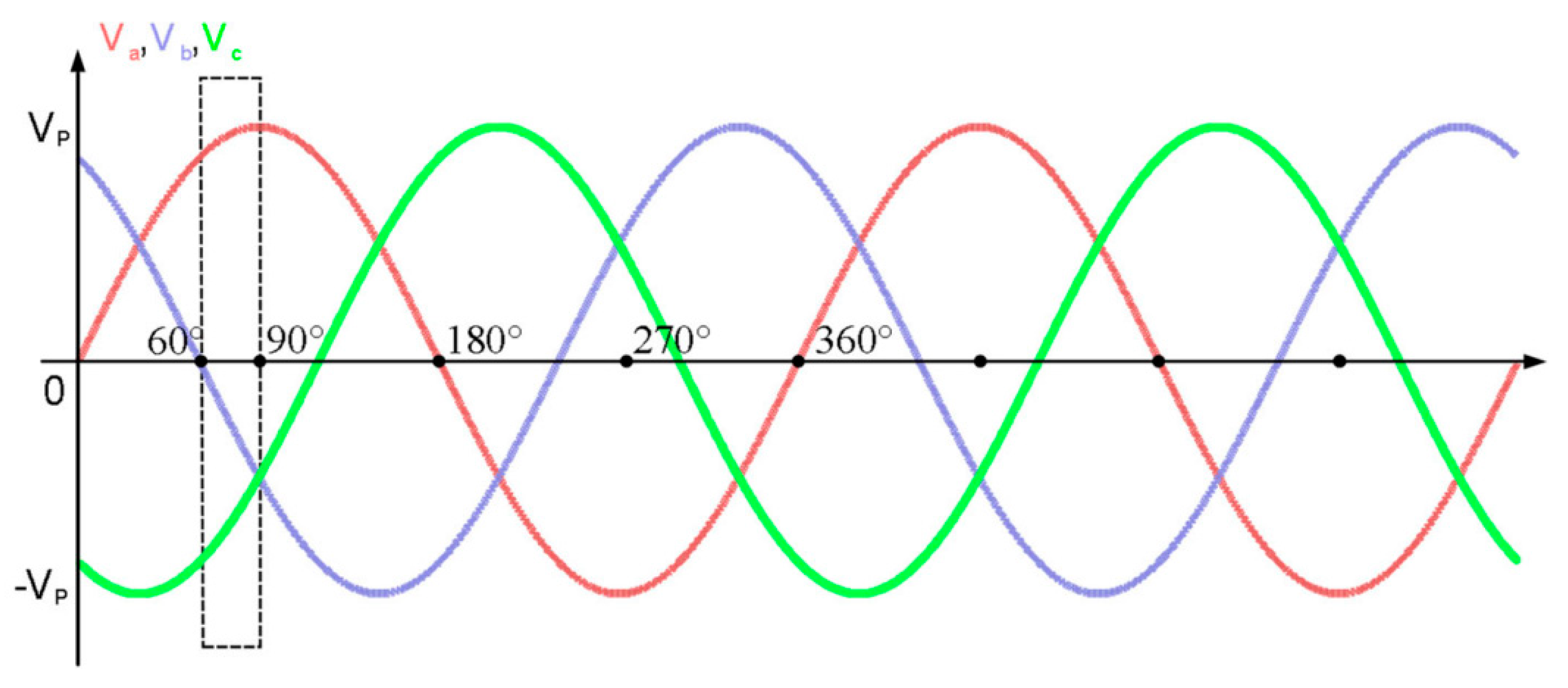


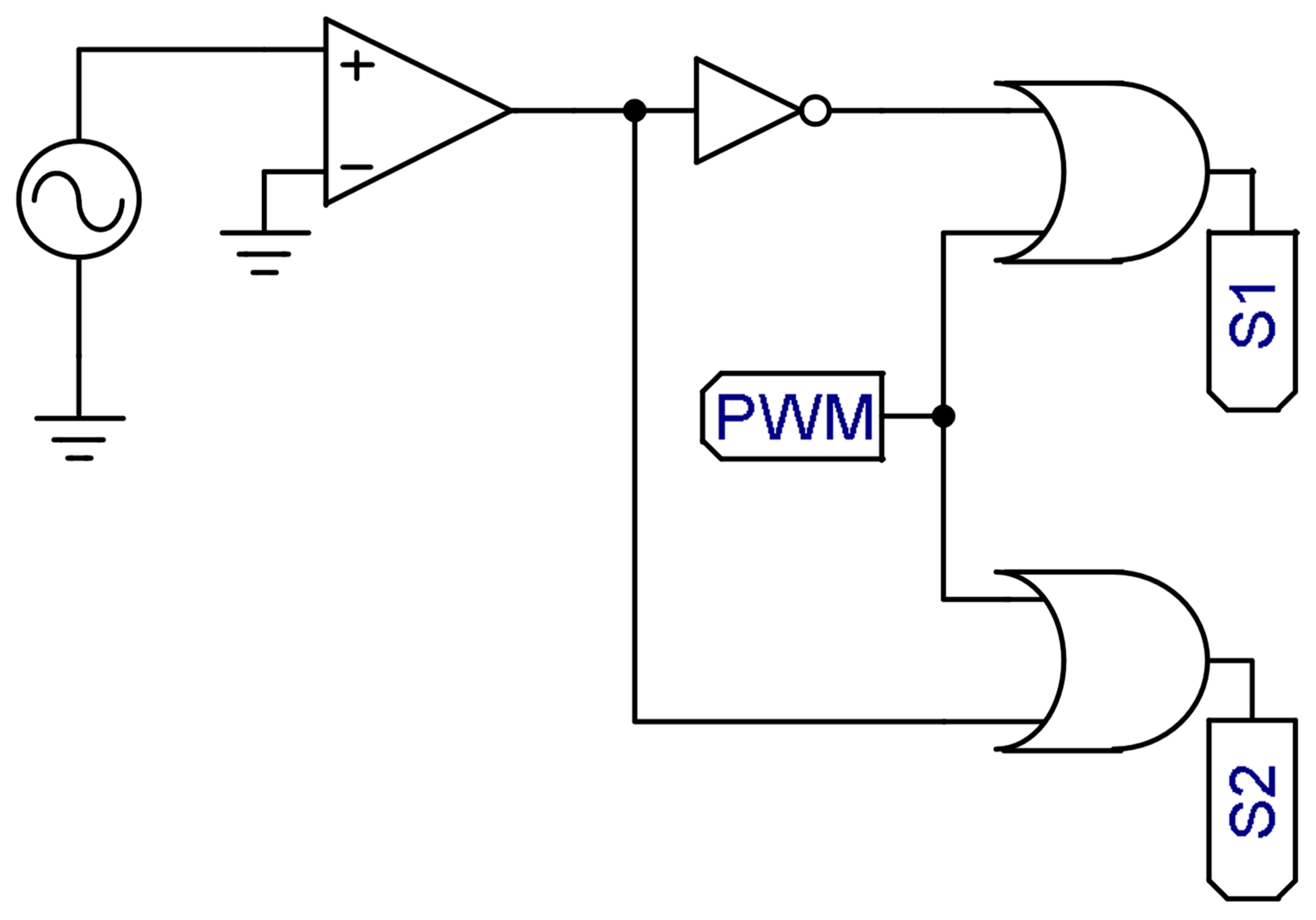

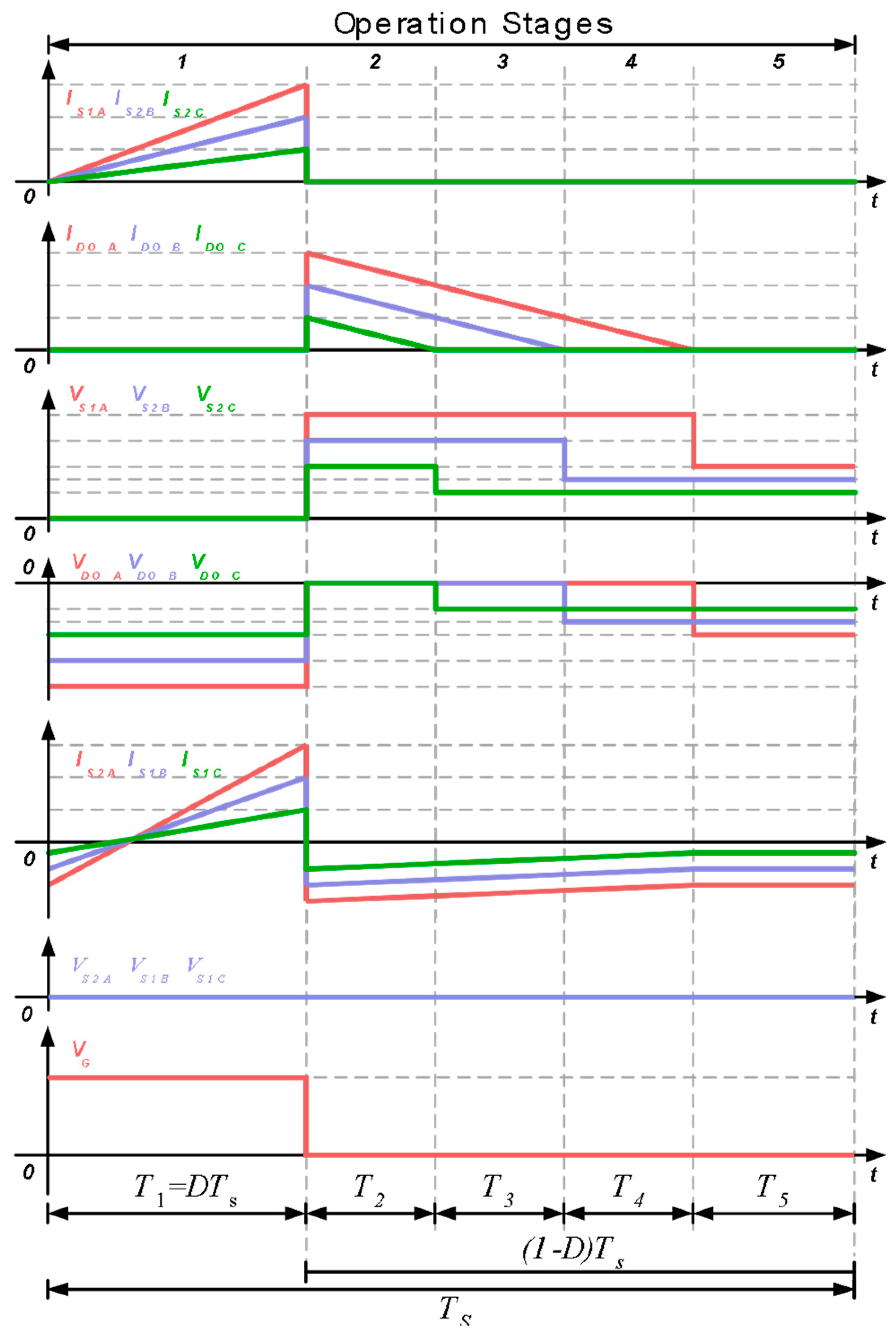


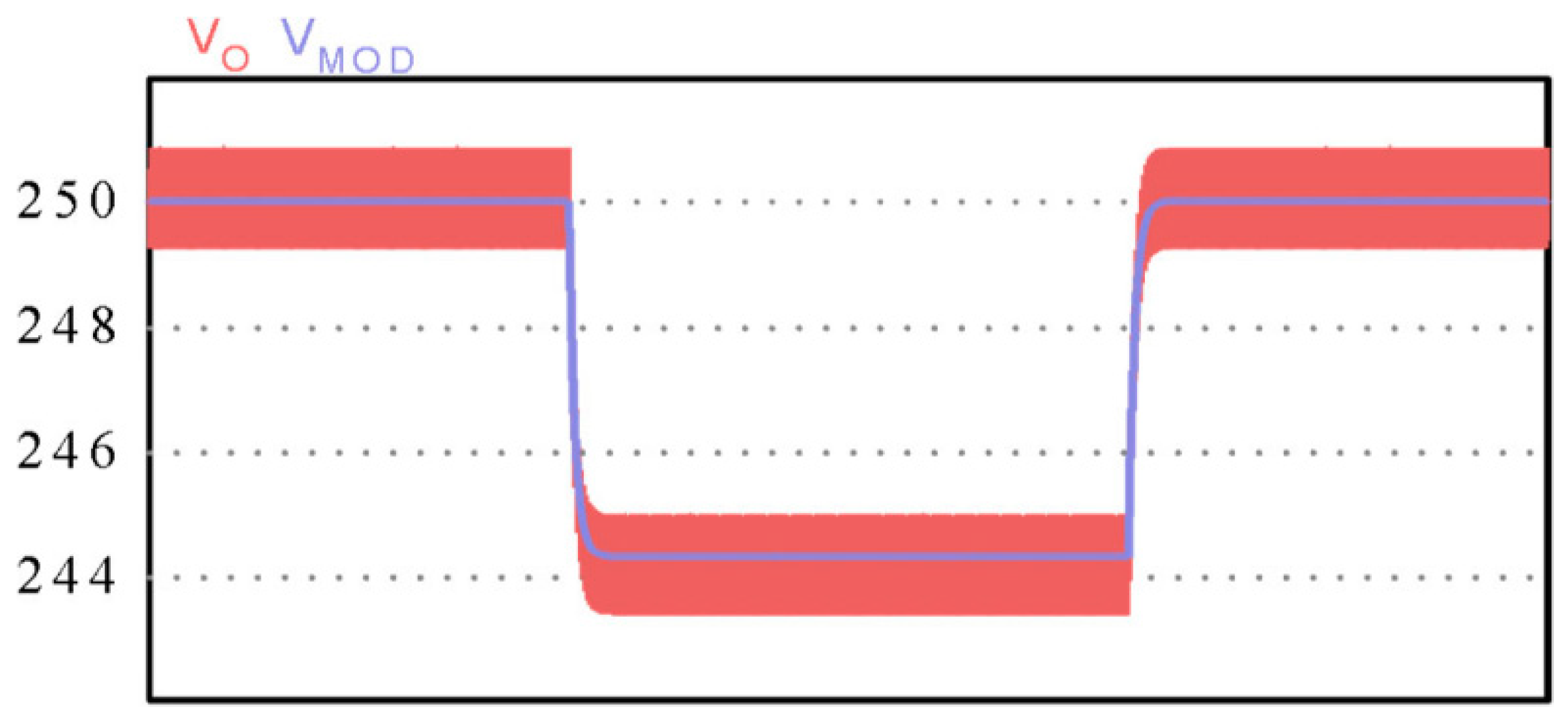




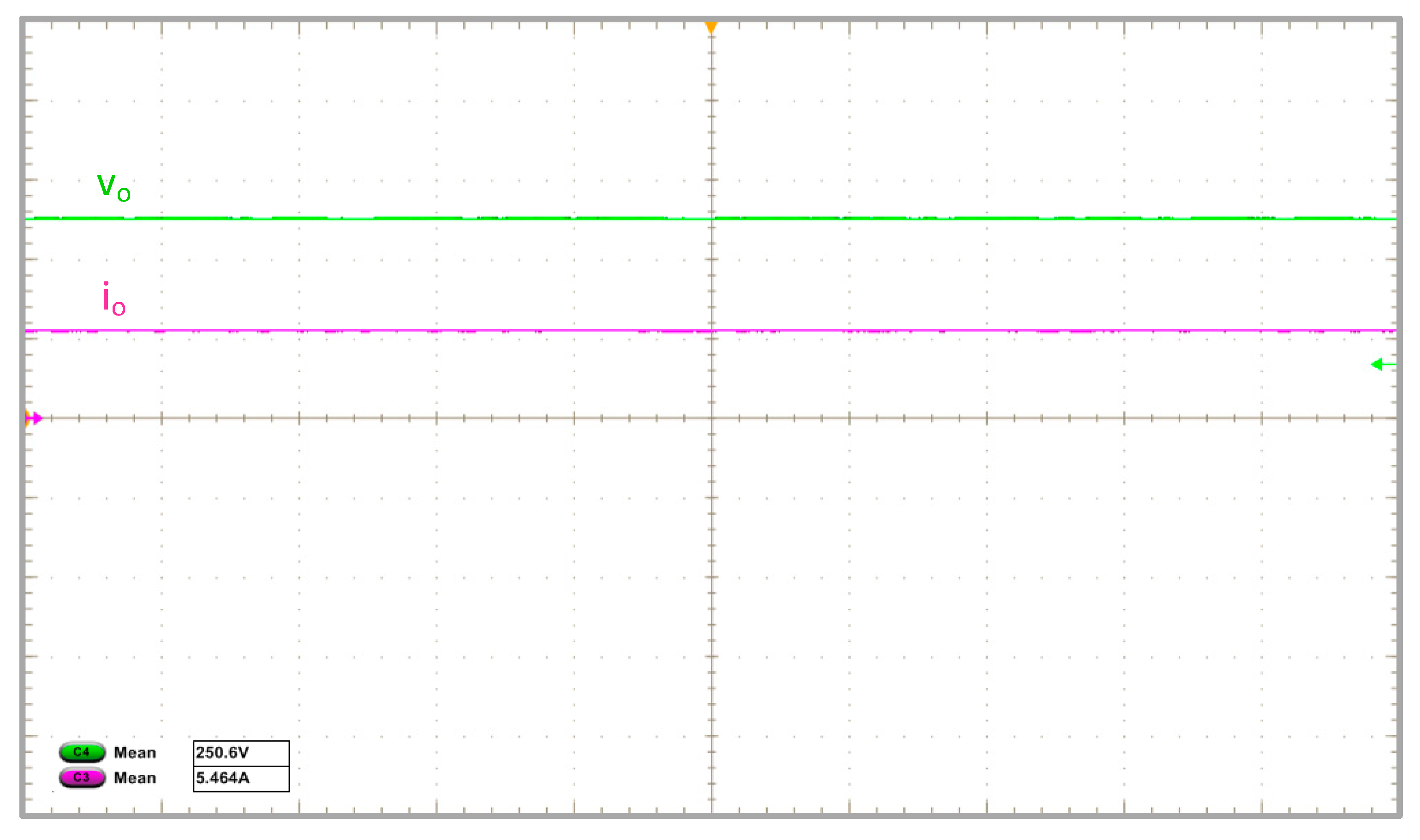


| Specification | Value |
|---|---|
| Output power () | 1500 W |
| Input voltage () | 90 V |
| Output voltage (Vo) | 250 V |
| Maximum duty cycle (D) | 0.55 |
| Switching frequency (fs) | 25 kHz |
| Ripple voltage in capacitors () | 28.5% |
| Ripple current in input inductors () | 12% |
| Hold-up time () | 8 ms |
| Specification | Value |
|---|---|
| Transistors | SPW47N60C3 (650 V/47 A) |
| Rectifier diodes | 1N5408 (1000 V/3 A) |
| Output diodes | MUR860 (600 V/15 A) |
| Input inductors | Inductance: 2.916 mH Number of turns: 144 Wire conductor: 16 AWG Toroidal core: APH46P60 |
| Output inductors | Inductance: 101.412 µH Number of turns: 29 Wire conductor: 64 × 32 AWG EE core: EE42/21/15 3C90 |
| Input capacitors | 2 × 2.2 µF/250 V |
| Output capacitor | 3 × 470 µF/400 V |
Disclaimer/Publisher’s Note: The statements, opinions and data contained in all publications are solely those of the individual author(s) and contributor(s) and not of MDPI and/or the editor(s). MDPI and/or the editor(s) disclaim responsibility for any injury to people or property resulting from any ideas, methods, instructions or products referred to in the content. |
© 2023 by the authors. Licensee MDPI, Basel, Switzerland. This article is an open access article distributed under the terms and conditions of the Creative Commons Attribution (CC BY) license (https://creativecommons.org/licenses/by/4.0/).
Share and Cite
Lima, G.F.d.; Kremes, W.d.J.; Siqueira, H.V.; Aliakbarian, B.; Converti, A.; Illa Font, C.H. A Three-Phase Phase-Modular Single-Ended Primary-Inductance Converter Rectifier Operating in Discontinuous Conduction Mode for Small-Scale Wind Turbine Applications. Energies 2023, 16, 5220. https://doi.org/10.3390/en16135220
Lima GFd, Kremes WdJ, Siqueira HV, Aliakbarian B, Converti A, Illa Font CH. A Three-Phase Phase-Modular Single-Ended Primary-Inductance Converter Rectifier Operating in Discontinuous Conduction Mode for Small-Scale Wind Turbine Applications. Energies. 2023; 16(13):5220. https://doi.org/10.3390/en16135220
Chicago/Turabian StyleLima, Guilherme Ferreira de, William de Jesus Kremes, Hugo Valadares Siqueira, Bahar Aliakbarian, Attilio Converti, and Carlos Henrique Illa Font. 2023. "A Three-Phase Phase-Modular Single-Ended Primary-Inductance Converter Rectifier Operating in Discontinuous Conduction Mode for Small-Scale Wind Turbine Applications" Energies 16, no. 13: 5220. https://doi.org/10.3390/en16135220
APA StyleLima, G. F. d., Kremes, W. d. J., Siqueira, H. V., Aliakbarian, B., Converti, A., & Illa Font, C. H. (2023). A Three-Phase Phase-Modular Single-Ended Primary-Inductance Converter Rectifier Operating in Discontinuous Conduction Mode for Small-Scale Wind Turbine Applications. Energies, 16(13), 5220. https://doi.org/10.3390/en16135220










